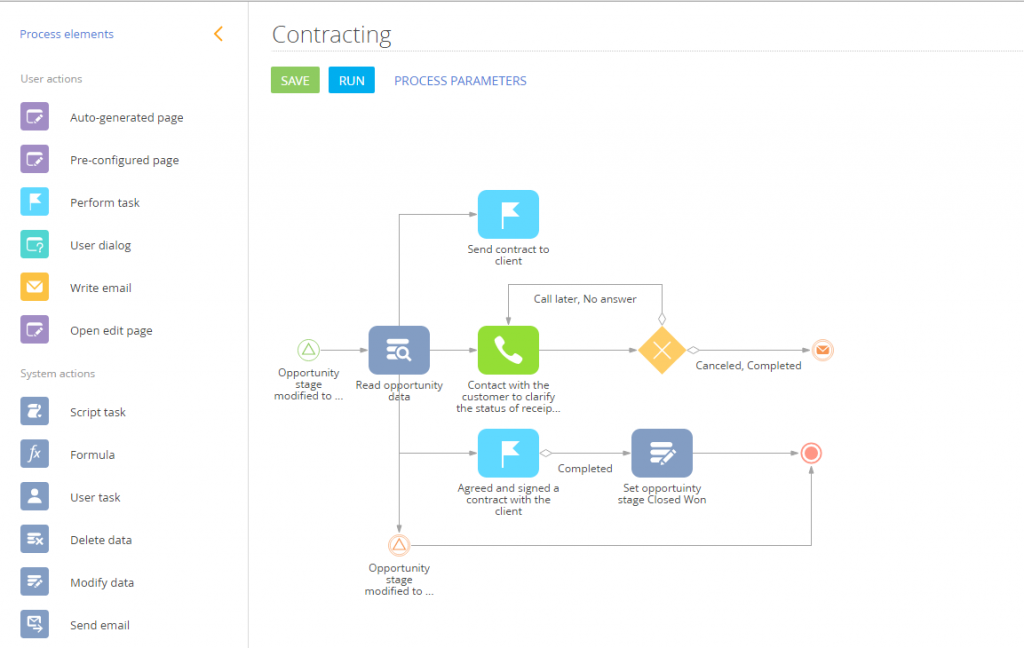Companies have their own targets, such as selling more products, improving customer experience, reducing operational costs, and expanding the market share. In order to achieve these goals quickly and effectively, organizations have to develop robust business processes, also referred to as best practices, workflows, patterns of work, steps, or algorithms. The processes are found throughout the business: in apps, emails, manual efforts, employees’ heads, and paper forms. The deployment of software BPM allows these procedures to get identified, systematized, improved, and automated.
A lean BPM platform like the bpm’online suite available at https://www.bpmonline.com alligns people and technologies to make both parties move towards the common goal. A business process management approach makes routine organizational operations more dynamic and flexible to respond properly to the market changes. It solves the most urgent issues related to documentation, management, and control:
- Costs optimization. Today, cost saving is crucially important. Current economic conditions force enterprises to become as dynamic as possible to maximize cost efficiency. By deliveringprocess optimization, workflow planning, and task management and supporting an organization with rich analysis, customizable reports, and real-time monitoring, software BPM enables the reps to work much productively, performing projects in a cost-wise manner and without overstepping the budgets.
- Resources allocation. The right BPM software solutions promote consistent accountability and smart task assignment. Instead of forcing the members to execute the tasks they are not very good at, a business leader now is able to make an optimal utilization of their real performing abilities. The reps can focus on these tasks and operations that suit their talents best of all and thus work more effectively. Know how your sales team can benefit from BPM on http://salesmanagementsoftwarecrm.com/bpm/bpm-system/.
- Work automation. Modern BPM products are aimed to automate the manual work, which is very time-consuming. Together with eliminating human errors, the program can streamline the business processes and speed up the response time. With tasks handled more efficiently, organizations drive a competitive edge over the rivals and increase their returns on investments (ROI).
- Process transparency. Sophisticated BPM solutions provide insightful monitoring of processes’ performance. This feature delivers overall business transparency and problematic areas are clearly highlighted. The package also allows for more comprehensive tracking and reporting. Download a BPM ebook to learn what other business challenges both anon-premise and an online BPM software can cope with. And we go on with understanding the phenomenon of business process management.
Features of a Good Software BPM
Full-featured BPM systems are designed to solve a company’s business problems by aligning core processes with the customers’ needs. The program allows for creating business applications being based on the streamlined, managed, and continuously improved end-to-end business workflows. BPM softwares accelerate speed, visibility, consistency, and flexibility of the organizational operations – critical components of efficient business processes. An intelligent BPM platform comprises technology, best practices, and content to start a successful business transformation:
Process Execution
A smart BPM program offers a powerful process designer to capture, map out, simulate, implement, monitor, and improve business workflows throughout the departments and across the entire company. By creating an adaptive process landscape, the application helps stakeholders prevent errors, identify bottlenecks, handle exceptions, diminish redundant tasks, and erase inefficiencies within processes.
Rules Management
A rules engine is an integral component of software BPM. The component helps to easily define, integrate, and change business rules within a process during modeling by using the pre-defined logic to forecast the outcomes. The engine enables accurate decision making. Plus, it is essential for complex dependencies where organizational or regulatory changes involve changes in a process’s logic. With BPM rules management, companies can avoid penalties and fines, which can appear due to non-compliance.
Monitoring and Analytics
A progressive business process management system generates customizable graphical charts to provide visualizations for process instances that are based on different timeframe filters and embedded KPIs and get real-time statistics on the activities and tasks. This instrument empowers the reps to keep up with corporate goals and associated SLAs with help of configurable alerts and notifications, thus they can take immediate actions to address violations or breaches, which occur during a process execution.
Collaboration
BPM software tools boost cooperation via extensive collaborative features that involve a live chat, instant messages, corporate email, message boards, calls, and group video conferences. The suite aligns social tools with the work practices so that the staff is able to communicate much easier, perform better, and manage the organizational resources more effectively.
Administration
A fine BPM system such as the bpm’online business solution can boast solid administration capabilities including:
- Task management
- Project management
- Resources management
- Customer relationship management
- Big data management
- Web service management
- User access and permission management
- Case management
- Mobile support
- Other software integration
Evidently, a multi-functional BPM platform does not only transform existing workflows, but serves as an all-mighty company manager, which is able to deal with any business issue. A business process management system is meant for business optimization first of all. Such software enhances productivity by orchestrating core processes. By introducing a BPM-approach, organizations can save operational time, decrease redundancy, and build remarkable revenues – that are the key factors that drive a strong competitive advantage.
